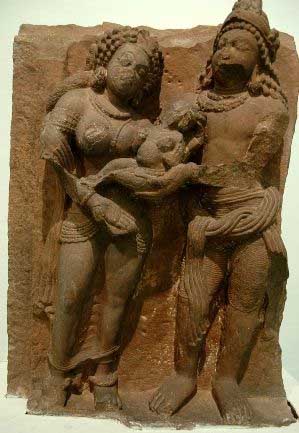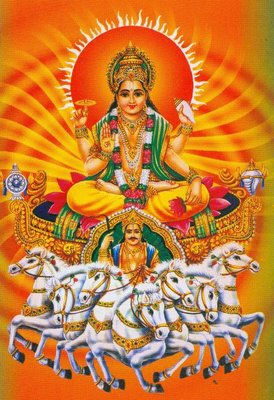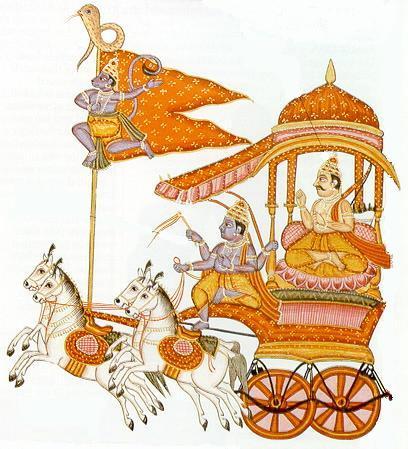by D.M. Murdock/Acharya S
"The Mahabharata and the Puranas are unanimous in saying that the god Krishna was an incarnation of the god Vishnu, born as the son of Vasudeva and Devaki... His story is made up of marvellous legends. From them scholars have tried to eliminate his godhood and all that is extravagant and physically impossible, and reduce him to a human being who, born as the son of one Vasudeva, made his name as a great Kshatriya hero, but who subsequently was deified for the purpose of hero-worship. But in the case of Krishna, instead of a man being deified, the contrary seems to me to be the case, viz., that god Vishnu is anthropomorphized and made man—god-man—as Krishna Vasudeva.... Likewise Krishna [is] identical with Vishnu, the God of Sacrifice..."
Aiyangar Narayan, Essays on Indo-Aryan Mythology (478)
"Vishnu, being moved to relieve the earth of her load of misery and sin, came down from heaven, and was born of the virgin Devaki, on the twenty-fifth of December."Sarah E. Titcomb, Aryan Sun Myths (37)
"[In] India...in celebration of the new solar year, or the birth of the pastoral god Krishna...it is customary, towards the end of December, to give cows to the Brahmans, exchange presents..."Angelo De Gubernatis, Zoological Mythology (I, 51)
 Traditionally, the Indian god Krishna is said to have been born during the summer months, usually in June, July, August or September. The facts that his birthday is cited as having occurred on the "eighth day of a dark fortnight" and that the date varies from place to place and era to era indicate that we were dealing with a mythical motif, not a historical event. As I relate in my book Suns of God: Krishna, Buddha and Christ Unveiled (229-230):
Traditionally, the Indian god Krishna is said to have been born during the summer months, usually in June, July, August or September. The facts that his birthday is cited as having occurred on the "eighth day of a dark fortnight" and that the date varies from place to place and era to era indicate that we were dealing with a mythical motif, not a historical event. As I relate in my book Suns of God: Krishna, Buddha and Christ Unveiled (229-230):There is no agreement even as to the epoch in which Krishna was "born." Nor is there concurrence as to the particular month of his birth. Even in modern times there is no consensus, except that he was born on the eighth day of a dark fortnight. Indeed, "in Krishnaism itself there are different dates for the Birthday Festival, the Varaha Purana entirely departing from the accepted view." Robertson states that the "Krishna Birth-Festival"...is equivalent to July 24th. Another writer gives Krishna's exact birthdate as July 20, 3228 BCE. Yet another source says that it happened in "the dark half of Bhadrapada," a month beginning on August 23rd and ending on September 22nd, according to the Indian civil calendar, and occurring from August 16th to September 15th, according to the religious calendar. The [birthday of Krishna] has also been placed on the 8th of the month Sravana, which in the civil calendar runs from July 23rd to August 22nd, making it equivalent to the zodiac sign of Leo, while in the religious calendar, it is July 16th to the 15th of August. That these dates are not "historical" but manipulated is revealed in the fact that, "while the Birth Festival falls in July, the date of the birth in later texts appears to be August."...Moreover, Krishna's birthday, also called Jananashtami, Krishnaastami, Crishnajanmashtami, Gokulashtami, etc., occurs on different days in different years. In 1993, Krishna's birthday was celebrated in July, in some parts of the world. However, in 1996, it was celebrated on September 4th or 5th, again depending on the place. In 1997, his birthday occurred on August 25th. In the year 2000, it fell on August 22nd or 23rd:Krishna took birth at midnight on the ashtami or the 8th day of the Krishnapaksha or dark fortnight in the Hindu month of Shravan (August-September). This year Janmashthami, as this auspicious day is called, falls on the 23rd of August, 2000.Other dates include September 2nd or 3rd, September 12th, September 27th and so on. As can be seen, the month, like the day and year, is not agreed upon: Some sources claim Lord Krishna was born in the month of Bhadra or Bhadrapada, which is August/September; others say the month is Sravana or Shravan, corresponding to July/August. Adding to the confusion, in the Bhagavad Gita (10:35), Krishna is identified as the month of November/December, which indicates that said month is very important for his followers: "Of all the nuwsas (months), I am the margasira (November-December)."
In this regard, Indologist Dr. E. Washburn Hopkins remarks that "the Puranas that describe the Birthday Festival of Sri Krishna give the time variously on different dates (between June and September) though they all agree that the hour is midnight." (Hopkins, 166)
In light of his traditional summer, rainy-season birth, the contention made by several writers over the past couple of centuries that Krishna was born on "December 25th" or the winter solstice appears to be a mistake. Oddly enough, however, this "error" may have revealed a mystery for the higher initiates in the Indian religion: To wit, Krishna is a mythical incarnation of the solar deity Vishnu, who is said to "sleep" and then "rise" at the winter solstice or "December 25th." (Tod, 448)
'Christmas' is the winter solstice
It should be understood that the phrase "December 25th" refers to the period of the winter solstice, which has been celebrated over the millennia on not only the day we call "December 21st," according to the Gregorian calendar, but also several other days in both December and January. These festivals include multiple-day celebrations such as the Roman Saturnalia, which ran from  December 17th to the 23rd. Other winter-solstice observances include December 22nd through the 26th—with the typical triduum or three-day period from the 21st to the 24th at midnight—and January 5th, 6th, 7th, 14th and 15th.
December 17th to the 23rd. Other winter-solstice observances include December 22nd through the 26th—with the typical triduum or three-day period from the 21st to the 24th at midnight—and January 5th, 6th, 7th, 14th and 15th.
 December 17th to the 23rd. Other winter-solstice observances include December 22nd through the 26th—with the typical triduum or three-day period from the 21st to the 24th at midnight—and January 5th, 6th, 7th, 14th and 15th.
December 17th to the 23rd. Other winter-solstice observances include December 22nd through the 26th—with the typical triduum or three-day period from the 21st to the 24th at midnight—and January 5th, 6th, 7th, 14th and 15th.The "rise," "rebirth" or "resurrection" of the sun god at the winter solstice is a common theme globally, reflected in myths and artifacts dating back thousands of years. In this regard, the winter solstice is an important holiday in India as well, currently celebrated on January 14th, called "Makar Sankrati." The next day, January 15th, is styled "Surya Pongal" or Sun God Day, after the main Indian solar deity, Surya, which is but one of the many names of the sun.
The Many Names of the Sun God
As we know from Egyptian mythology, for example, numerous ancient gods are interchangeable in their characteristics and attributes; the same can be said of various Indian gods, especially when it comes to the "sun gods" or deities who possess solar attributes. In reality, many Indian gods are deemed solar, and their names represent aspects of the sun, grouped in numbers of 12 to the sacred 108.
Although they vary from source to source, one list of the "twelve general names of the sun god" includes: "Aditya, Savita, Surya, Mihira, Arka, Prabhakara, Martanda, Bhaskara, Bhanu, Citrabhanu, Divakara and Ravi." The twelve "Adityas" as found in the Vishnu Purana and as correlate to the months of the years are as follows:
Indra, Dhatr, Parjanya, Pusan, Tvastr, Aryama, Bhaga, Vivasvat, Visnu, Amsu, Varuna and Mitra. (Singh, 2361)
In the Encyclopaedia of Hinduism, Dr. Rajendra Singh (2499) explains that while Surya is one the 12 names of the sun god, Vishnu is one of the appellations of Surya, who "possesses twelve names for each of the months of the year..." In Vaishnavism, Lord Vishnu is the sun or solar genius during the month of "Chaitra" or "Caitra," which begins on the vernal equinox or March 20th in the Indian civil calendar. Vishnu himself has 1,000 names, as can be found in the Vishnu Purana by B.K. Chaturvedi.
Vishnu the Sun
As concerns the correlation between mythical Indian figures and celestial bodies or events, the Indian scholar Aiyangar Naryan deems the mythical characters as "metamorphoses" of various stars and/or constellations or "asterisms." His book is called Essays on Indo-Aryan Mythology, demonstrating that Indian scholars understand these stories as myths, not history. Discussing Vishnu, Narayan remarks:
He is described by means of several metaphors. One of them is that he is the sun. (93)
 Regarding the motif of the sun god Vishnu's "three strides" across the sky, Naryana further says that "his three strides are his placing one step at the point of the winter solstice in the south (the beginning of the Uttarâyana), the second step at the point of the vernal equinox, and the third step at the point of the summer solstice in the north..." (94)
Regarding the motif of the sun god Vishnu's "three strides" across the sky, Naryana further says that "his three strides are his placing one step at the point of the winter solstice in the south (the beginning of the Uttarâyana), the second step at the point of the vernal equinox, and the third step at the point of the summer solstice in the north..." (94)Hence, Vishnu is the sun or a solar genius, and his "life" and "adventures" represent astrotheological interpretations of the sun's movements, especially of the important annual milestones of both solstices and the spring equinox. As noted, Vishnu is said to "rise" at the winter solstice, which is a sort of rebirth common in the stories of sun gods.
Krishna as Solar Deity
As we can see from his quote asserting Krishna to be a manmade anthropomorphization of Vishnu, rather than a man made into a god, as in evemerism or apotheosis, Narayan contends that "Krishna is identical with Vishnu," who is also a solar deity or genius of the sun.
In discussing the asterism or constellations and stars incarnated in various figures in the Krishna birth myth, including both the god's parents and his foster-parents, Naryan remarks:
As these are the asterisms in whose region the Sun's winter solstice or the renewal of the Uttarâyana of the olden time was taking place, let us take the child Krishna placed with [the fosterparents] for protection to be Vishnu's solar aspect. (506)
Here the scholar seems to be saying that because the parents and fosterparents of the Krishna myth are "metamorphoses" of the constellations in the celestial region of the winter solstice—the Uttarâyana being the six-month sosticial period that starts on January 14th, the Makar Sankrati or Indian winter-solstice—the baby Krishna can be understood as "Vishnu's solar aspect." In other words, Krishna is the sun born at the winter solstice. Furthermore, in discussing Krishna's birth in the rainy season, Narayan assumes Krishna to be "not only the metaphorical rain-cloud, but also the Sun as the cause of rain..." (506) In this case, then, it is apparent that Krishna is the sun born at the summer solstice.
 After reviewing some of Krishna's deeds in the Puranas, Narayan remarks, "I would view these four acts of Krishna as a description of the career of the Uttarâyana Sun..." (508) The fact that Krishna is viewed by this Indian scholar as the incarnation of the Uttarâyana sun further indicates his perception that the god is born also at the winter solstice. Moreover, the contention that, during the winter-solstice celebrations Indians of Orissa, for one, have proceeded through their villages carrying images of the "youthful Krishna," would indicate this connection as well.
After reviewing some of Krishna's deeds in the Puranas, Narayan remarks, "I would view these four acts of Krishna as a description of the career of the Uttarâyana Sun..." (508) The fact that Krishna is viewed by this Indian scholar as the incarnation of the Uttarâyana sun further indicates his perception that the god is born also at the winter solstice. Moreover, the contention that, during the winter-solstice celebrations Indians of Orissa, for one, have proceeded through their villages carrying images of the "youthful Krishna," would indicate this connection as well. It is possible that this apparent tradition of Krishna's birth at the renewal of the Uttarâyana sun is the same as the celebration discussed by Dr. Angelo Gubernatis, a professor of Sanskrit and Comparative Literature at the Istituto di Studii Superiori e di Perfezionamento, quoted above as stating that the birth of the pastoral god Krishna was celebrated at the "end of December."
The "mistake" of identifying the summer-solstice month of Sravana—in which Krishna is said to have been born—with December appears to have been based on the fact that in Indian mythological astronomy Sravana is also a star, "whose regent is Vishnu" and which can be seen "on the new-moon day at the beginning of the Uttarâyana...." (Narayan, 3) The six-month summer-to-winter-solstice period begun by the month of Sravana and Krishna's rainy-season birth is called the "Dakshinyana." It thus appears from Narayan's extensive analysis that there is a tradition in which "Krishna" refers to the baby sun born at the beginning of both six-month periods marked by the solstices. As we can see, rather than being a cut-and-dry biography of a "real person," there is much more to this mythical story than meets the eye.
For more information about the solar nature of Krishna, his birthday and the winter solstice in India, see Suns of God. Whether or not the sun's annual return is called a "birth," "rising" or "resurrection," whether or not it is held in December or January in the northern hemisphere or June 21st or 24th in the southern, and by whatever name the sun may have been called, the effect is still the same, and the motif of "Christmas" or the Light of the World being born at the winter solstice remains unoriginal in Christianity, the demonstration of which is the main purpose of this comparison.
Bibliography
"India Celebrates Harvest Festivals, Three Chariot Festival in Udupi," www.harekrsna.com/sun/news/01-07/news958.htm"Names of Sun God, Brahma Purana," www.indianetzone.com/46/names_sun_god.htm
"Twelve Names of the Sun"
www.gloriousindia.com/scriptures/puranas/vishnu_purana/twelve_names_of_the_sun.html
Acharya S. Suns of God: Krishna, Buddha and Christ Unveiled. IL: AUP, 2004.
Chaturvedi, B.K. Vishnu Purana. New Delhi: Diamond Pocket Books, 2006.
De Gubernatis. Zoological Mythology; or, The Legends of Animals, I. London: Trubner & Co., 1872.
Hopkins, Edward Washburn. India Old and New. New York: Charles Scribner's Sons, 1901.
Narayan, Aiyangar. Essays on Indo-Aryan Mythology. New Delhi: Asian Educational Services, 1987.
Singh, Nagendra. Encyclopaedia of Hinduism. New Delhi: Anmol Publications, 2000.
Titcomb, Sarah E. Aryan Sun-Myths: The Origin of Religions. Boston: Estes and Lauriat, 1890.
Tod, James. Annals and Antiquities of Rajasthan, I. London: Routledge & Sons, 1914.


No comments:
Post a Comment